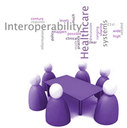MMI 405 - Interoperability

Interoperability is the keystone for future development in informatics. A multitude of individual methods for creating and storing medical data have been developed, but the ability to share them securely and consistently has been lagging. The development of universally accepted standards for interoperability will begin to reformulate the individual approaches to record keeping. Understanding the interaction between systems and the development of standards will be key to developing effective and efficient systems.
Information architecture within health care organizations becomes the backbone upon which all other interactions occur. Using adequate standards to accomplish this represents both a compromise and an advance. Every organization will have to modify, and likely reduce the robustness of their information sharing in order to comply with the necessary and appropriate standards, but the ability to share data cleanly, rapidly and consistently eventually offers greater strength. Exploring the wide variety of US standards for Healthcare Information Technology (HIT) allowed our team to analyze intra- and inter-organizational data exchange issues as we built our project. These included the characteristics of health information exchanges and data warehouses.
The "ATM model of Healthcare" utilized the simplicity of the banking ATM model to create an opportunity for patient controlled information sharing within a community network. This process explored the minimum necessary information that would be required for patient care and levels of security available.
Having explored the interoperability standards and their application, it will be easier to manage conversations and planning sessions in the future. It is unlikely that I will become an expert in these areas, but I know where I can find information when I need it and the ability to ask critical questions on behalf of my hospital.
Individual Paper Group Paper Presentation MMI Overview Coursework Projects Home
*image from http://fcp.com/healthitblog/?p=441
Information architecture within health care organizations becomes the backbone upon which all other interactions occur. Using adequate standards to accomplish this represents both a compromise and an advance. Every organization will have to modify, and likely reduce the robustness of their information sharing in order to comply with the necessary and appropriate standards, but the ability to share data cleanly, rapidly and consistently eventually offers greater strength. Exploring the wide variety of US standards for Healthcare Information Technology (HIT) allowed our team to analyze intra- and inter-organizational data exchange issues as we built our project. These included the characteristics of health information exchanges and data warehouses.
The "ATM model of Healthcare" utilized the simplicity of the banking ATM model to create an opportunity for patient controlled information sharing within a community network. This process explored the minimum necessary information that would be required for patient care and levels of security available.
Having explored the interoperability standards and their application, it will be easier to manage conversations and planning sessions in the future. It is unlikely that I will become an expert in these areas, but I know where I can find information when I need it and the ability to ask critical questions on behalf of my hospital.
Individual Paper Group Paper Presentation MMI Overview Coursework Projects Home
*image from http://fcp.com/healthitblog/?p=441